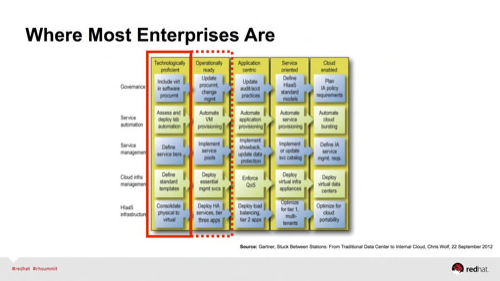Every enterprise wants to be Amazon these days. Tempted by the promise of cheap, elastic cloud computing, companies are rolling out OpenStack and other private cloud solutions, certain that they’re building a winged unicorn.

In reality, many of them are building a donkey.
That’s the message from former Gartner analyst and Red Hat general manager Alessandro Perilli, who delivered it at the most recent Red Hat Summit. But rather than mope in the valley of diminished expectations, Perilli suggested a few ways businesses can grow into their most optimistic dreams of cloud computing.
Lowering Your Sights For The Company Cloud
Enterprises have huge visions for their private clouds, based in large part on their experience with public “infrastructure-as-a-service” clouds like Amazon Web Services. So when they take OpenStack or some other private cloud technology for a spin, they assume it’s going to be:
• Simple
• Cheap-ish
• Standardize and fully automated
• “Elastic” at the application level, meaning it will automatically expand or trim back computing resources for any given job as demand waxes and wanes
• Resource consumption-based
• Infinitely scalable at the infrastructure level, meaning that companies can build out their cloud deployment as much as they want
• Minimally governed like AWS, with the ability to get work done without heavy interference from IT (and IT policies)
What they actually find, though, is a setup that is:
• Undeniably complex
• Expensive
• Only partially standardized and barely automated
• Not as elastic as they’d hoped
• Capacity constrained
• Heavily governed by IT attempting to layer onto cloud resources a full suite of access and financial controls, key management and encryption and other tools
This is what the reality of enterprise cloud applications look like today, suggested Perilli:

Not surprisingly, once enterprises bump into this uncomfortable reality, the public cloud starts to look even more appealing. Turns out that it’s extraordinarily difficult to build an internal data center that functions like a fully elastic cloud.
Start Small, Dream Big
Rather than launch a fully-automated production cloud, Perilli suggests that organizations start small, even if they’re ultimately thinking big. After all, there’s a progression of complexity as enterprises attempt to move data center applications to a cloud environment. The more components an app has, the more provisioning is required. The more pieces an enterprise tries to automate, the harder its job will be.
As he argued:
Yes, you can build a cloud in six months, but that is just the beginning. You need to add pieces and evolve the solution, and get more mature and add more control, and more capacity management. You don’t build all those components overnight.
That difficulty level goes up considerably once legacy systems are factored in, such as those old mainframe applications that are essential to the enterprise but not necessarily easy to integrate into cloud-based systems.
As such, it can take a company a year to convert 10 applications to the cloud. Given that enterprises will often have thousands of applications to convert, the task can seem daunting.
Perilli offers a few suggestions as to how to get started without getting overwhelmed:
1. Reset your expectations
2. Select a cloud solution that adjusts to your organization’s technological proficiency. Don’t buy a vendor’s bundle with six to 12 management modules when you can hardly use one or two of those
3. Build a solid development and test cloud first—and don’t believe anyone who tries to sell you on a “fully automated” production cloud
4. Introduce support for scale-out application in a meaningful way, in particular by considering a multi-tiered cloud architecture
Build With Trust
Finally, precisely because private clouds are still technologically immature, Perilli suggested that the most critical component of any cloud has nothing to do with technology:
[We] need to realise that, exactly because no solution is perfect despite all the marketing claims, what is more important is the trust, the relationship, the credibility that the vendor has.
In other words, building a viable enterprise cloud is a journey. So it’s important to pick your travel companions wisely.
Lead image courtesy of Shutterstock









